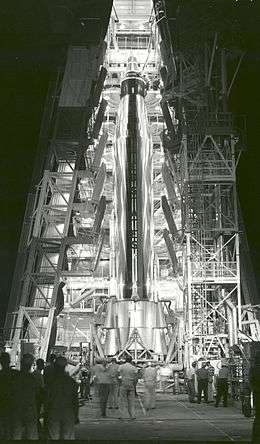Big Joe 1
 Big Joe 1 at LC-14 in September 1959 | |||||
| Mission type | Reentry test | ||||
|---|---|---|---|---|---|
| Operator | NASA | ||||
| Mission duration | 13 min | ||||
| Distance travelled | 2,292 kilometers (1,424 mi) | ||||
| Apogee | 153 kilometers (95 mi) | ||||
| Spacecraft properties | |||||
| Spacecraft type | Mercury boilerplate | ||||
| Manufacturer | McDonnell Aircraft | ||||
| Launch mass | 1,159 kilograms (2,555 lb) | ||||
| Start of mission | |||||
| Launch date | September 9, 1959, 08:19 UTC | ||||
| Rocket | Atlas D | ||||
| Launch site | Cape Canaveral LC-14 | ||||
| End of mission | |||||
| Landing date | September 9, 1959, 08:32 UTC | ||||

| |||||
Big Joe 1 (Atlas 10-D) launched an unmanned boilerplate Mercury capsule from Cape Canaveral, Florida on September 9, 1959. The objective of the Big Joe program was to test the Mercury spacecraft ablating heat shield. It was also the first launch of a spacecraft in Project Mercury.
Late on the night of September 8-9, Atlas 10D's engines roared to life on LC-14 and drove the Mercury capsule into the black sky. Everything performed perfectly until around the two-minute mark when telemetry readouts indicated that the booster section had failed to stage. The added dead weight of the engines meant that the Atlas could not attain its intended altitude and velocity, so that the sustainer engine used up its propellants and cut off 14 seconds early. Thanks to the premature SECO (Sustainer Engine Cutoff), the explosive bolts holding the capsule to the Atlas did not fire and it remained attached to its spent booster. Ground crews had to repeatedly fire the RCS (Reaction Control System) thrusters to tear the capsule free and in doing so exhausted the propellant supply. Navy recovery crews hurried to locate the capsule following splashdown and after a few hours, did so. The boilerplate Mercury was found to have survived the mission in good condition and verified the ablative heat shield. Plans for a beryllium heat shield in the event the ablative one did not work were scrapped.
The Mercury capsule flew a 1,424 mile (2,292 km) ballistic flight to the altitude of 90 miles (140 km). The capsule was recovered and studied for the effect of re-entry heat and other flight stresses from its 13-minute flight. Since the data from Big Joe 1 satisfied NASA requirements, a second launch, Big Joe 2 (Atlas 20D), which had been scheduled for the fall of 1959, was canceled and the launch vehicle was transferred to the Atlas Able program.
While the Mercury team was satisfied with the flight, Convair engineers were not. The Atlas had failed to stage its booster section and overall vehicle performance was rather marginal. They listed the flight in official records as a failure. The staging problem was ultimately traced to a probable bad electrical contact. Convair's morale was soon raised however by the successful launch of Atlas 12D from Vandenberg Air Force Base on the West Coast followed by the vehicle being declared officially "operational".
Capsule weight: 2,555 lb (1,159 kg). Serial numbers: Atlas 628/10-D, Mercury spacecraft - prototype.
The Mercury spacecraft used in the Big Joe 1 mission is displayed at the National Air and Space Museum's Steven F. Udvar-Hazy Center in Chantilly, Virginia.
See also
References
![]() This article incorporates public domain material from websites or documents of the National Aeronautics and Space Administration.
This article incorporates public domain material from websites or documents of the National Aeronautics and Space Administration.
- This New Ocean: A History of Project Mercury - NASA SP-4201
- NASA NSSDC Master Catalog
- Project Mercury preliminary flight test results of the Big Joe, Mercury R and D capsule (PDF) October 1959
